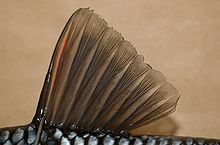Fin ray
As fin rays (Dermotrichia) the supporting elements are of the fish fins , respectively. With the various fish taxas, they can take four different forms:
- In the cartilaginous fish (Chondrichthyes) there are fibrous, elastic rays made of elastoidin , a horn-like substance. They are called Ceratotrichia .
- The fin rays in the outer, free fin edge of the ray fins (Actinopterygii), in the adipose fin of the Teleostei and the fin rays of their embryonic phase are called Actinotricha .
- The rays of the ray-finned and lobe-fins (Coelacanthiformes) are Lepidotrichia called. They can be derived from rows of scales and are originally structured. Their collagenous matrix is made up of mesenchymal cells that resemble osteoblasts . Lepidotrichia grows through terminal (at the end) ossification . Mature Lepidotrichia exist z. B. in salmon from a core of dense hydroxylapatite crystals , a bony middle layer and an outer layer of collagen fibers.
- The Kamptotrichia of the lungfish (Dipnoi) resemble the Lepidotrichia, but are covered with scales.
Hard and soft rays
The fin rays of the real bony fish (Teleostei) are divided into hard (also spiked rays) and soft rays (also limb rays). Hard rays are undivided, mostly smooth pieces of bone, soft rays consist of two halves that have grown together. A distinction is made between different forms of soft rays:
- undivided, undivided, prickly;
- undivided, structured;
- Fan-like divided, structured.
If a fin contains hard rays, these are always in front of the soft rays. The terms hard and soft rays are somewhat misleading. Hard rays can be flexible and soft, while undivided soft rays can be calcified and thorn-like. In case of doubt, the easiest way to distinguish between hard rays and non-structured soft rays is by looking from the front, which shows the two halves of the soft rays. Soft rays are always applied in pairs in the embryo and later grow together more or less.
Real hard rays can only be found in the barbedfish. In some fish, some hard rays are provided with poison glands (e.g. the scorpion fish , weever , rabbit fish ) and a saw-shaped profile on the back is also possible. They arise embryonically from unpaired bone rods.
Move
The fin rays are connected to one another by the connective tissue of the fin membrane and can be moved independently of one another due to their spacing. The fin rays of the Teleostei are made possible by two hinge joints to move forwards, backwards and sideways. Six muscles are available for this, the erector, which pulls the beam forward, the depressor , which is responsible for the backward movement, and two inclinators on each side. The stretched carinal muscles lie between the fins, which help to spread or lay them down.
Fin bearer
The fin rays (radii) of the unpaired fins (dorsal and anal fins) of the ray fins sit on bony bases, the fin supports (radialia, pterygiophores), which are part of the inner skeleton of the fish and reach down into the muscles. Each fin-bearer usually consists of three parts, a willow-leaf-shaped, long, proximal part, a shorter middle pterygiophore and the very short distal , cartilaginous pterygiophore to which the fin ray attaches. Only with the Teleocephala (the recent Teleosteern) is the number of fin rays in the dorsal fin equal to that of the fin bearers. The distal pieces are often tilted backwards and thus articulately connect two bases of the radii one behind the other as spacers. Mergers sometimes occur.
swell
- Kurt Fiedler: Textbook of Special Zoology, Volume II, Part 2: Fish. Gustav Fischer Verlag, Jena 1991, ISBN 3-334-00339-6 , pp. 40-42.
- Guillaume Lecointre, Hervé Le Guyader: Biosystematics: All organisms at a glance. Springer, Berlin 2005, ISBN 3540240373 , p. 450.

